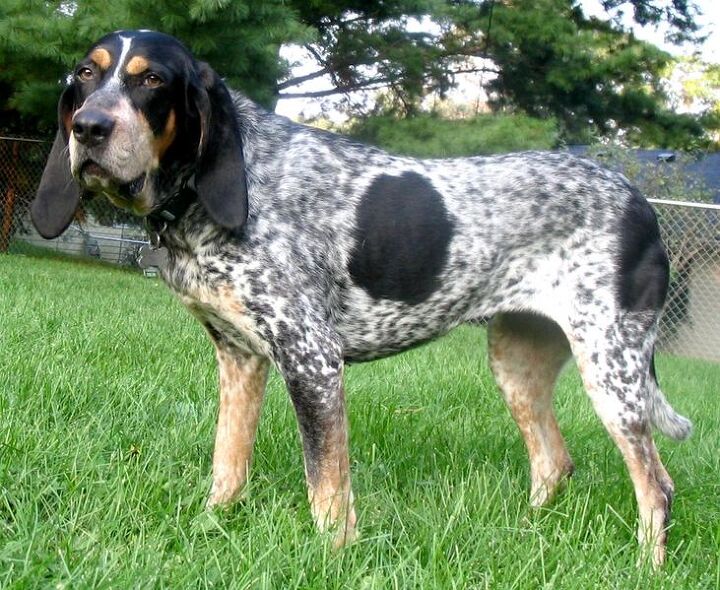Bluetick Coonhound


About Bluetick Coonhound
Bluetick Coonhound Basics
An all-American hunting dog, the Bluetick Coonhound is known for his athleticism, sociable nature, and great intelligence. Originally bred to chase and corner their prey into trees, letting the owner know of the capture with a distinctive howl, the breed especially loves to go after raccoons, hence the Coonhound part of their name. However, these days, Bluetick Coonhounds are not kept only as working dogs – their many qualities make them beloved family pets all across the United States.
Still, it is important to keep the roots of this breed in mind when considering adopting a Bluetick Coonhound, as their instincts remain even though they are not used to hunt racoons as much as they were when they breed was originally developed. The Bluetick Coonhound might get along well with children, but they will have a high prey drive, which means you will have to watch them if you have smaller animals in the household. If not given a task to do, these active dogs will find one by themselves – and usually, it’s some kind of trouble. One look in those adorable hound eyes, though, and all will be forgiven!
All things considered, the Bluetick Coonhound is an easy-going pooch who fits well into almost any environment as long as their needs are met. Train and socialize them on time and make sure they get plenty of exercise each day, and you’ll get to see only the best side of this loveable breed!
Origin
The Bluetick Coonhound is the state dog of Tennessee, so it shouldn’t come as too much of a surprise to learn that is where the breed is said to have originated. The breed was referred to as the English Coonhound for many years, but in 1945, Bluetick breeders broke from their English counterparts, as they were not interested in breeding a hot-nosed and faster hunter. The breeders renamed the larger, cold-nosed and resolute dog the Bluetick Coonhound and maintained their own hunting style.
Pedigree
The Bluetick Coonhound was descended from the Grand Bleu de Gascogne (French Staghound), English Foxhound, the cur dog, the American Foxhound, and the Black And Tan Virginia Foxhound.
Even though the Bluetick Coonhound has a well-documented history and an impressive pedigree, the breed was officially recognized by the AKC more than five decades after its origins, in 2009.
Food / Diet
You may find that your Bluetick Coonhound loves to eat fast. If so, feed your dog a few small meals daily – this will help your Bluetick Coonhound properly digest their food. A high-quality dog kibble is recommended, made for dogs of their size, age, and activity levels. In most cases, a formula for active dogs suits the Bluetick Coonhound well. Their chow should be made with natural, wholesome ingredients and real meat as the first ingredient on the list, and high in protein to give them fuel to go about their day and stay lean and in top shape.
As with any dog, it’s important to consult a veterinarian before establishing or altering your Bluetick Coonhound’s diet. Sure, dog food manufacturers and pet blogs provide useful feeding guidelines that can be referenced for advice. However, these are still only guidelines and should not be treated as gospel. All dogs are different after all, each with their own needs. The only person qualified to determine the specific dietary needs of your personal pooch is a vet, so always defer to their expertise before deciding what goes into your dog’s bowl.
Training
The Bluetick Coondog is a hunting dog, so expect some challenges in the training and housebreaking department. Always following its nose, the Bluetick Coondog is easily distracted by smells. Be firm when training, as this breed will ignore you if you are too lenient and gentle.
On the other hand, you’d do well to remember that the Bluetick Coonhound is sensitive to harsh words, so being too firm with these dogs can prove to be difficult. Don’t be discouraged because this breed is intelligent and performs trailing exercises very well. If you are not a seasoned pet owner, the Bluetick Coonhound will be a bit difficult to navigate, training-wise.
A delicate balance of positive reinforcement training and an assertive, confident attitude must be established to achieve the best results. If it proves to be too challenging to find that balance, then it might be a wise idea to enroll your Bluetick Coondog into some sort of training program. Not only will this take the pressure off (especially for any first time dog owners), but it will also help establish an early training regime. This is a wise option for dogs who are tricky to train and will pay off in the long run.
Weight
Male Bluetick Coonhounds weigh 55 to 80 pounds, while females weigh 45 to 65 pounds.
Temperament / Behavior
Bluetick Coonhounds are gentle and loyal dogs that grow to be very devoted and affectionate with their family members. You’ll find that your Bluetick won’t be aggressive to people, but you need to watch your dog around cats or other small animals. Those old hunting instincts are still buried within these pups, so they require extensive training and socialization to coexist with pets smaller than them.
An intelligent breed, the Bluetick Coonhound has a knack for problem-solving, so be sure to keep your pup stimulated and out of trouble. If they don’t live in a setting where they can express their working dog nature, regular exercise and mental stimulation are a must. Try interactive or puzzle toys for dogs or consider training them for agility sports – they sure have what it takes to succeed in them.
The Bluetick Coonhound needs plenty of space, and are generally not considered to be a suitable breed for apartment living. Bluetick Coonhounds will drool on occasion, and the breed loves to howl and bark, usually very loudly. The Bluetick Coonhound is a working hunting dog, so they will keep you busy. These dogs need attention and activities to thrive. As a result, these dogs are best suited to owners that can keep up and ideally live in a home with a big backyard, farm, or a similar rural setting.
Great with children and other people, the Bluetick Coonhound will be a mindful and friendly dog once trained. That nose will scope out food and garbage, so don’t leave it out unattended. Guests to your home will feel welcome, as your Bluetick Coonhound will greet them with a howl and a sniff. Because of their strong sense of smell, the Bluetick Coonhound makes a wonderful hunting and tracking dog.
Common Health Problems
The Bluetick Coonhound is a fairly healthy breed, but they are prone to hip dysplasia, cataracts, and Krabbe's disease. It’s important to maintain regularly scheduled checkups with a veterinarian (especially as your pooch ages into their senior years) to ensure that any potential health issues are identified and treated as quickly as possible.
Life Expectancy
Bluetick Coonhounds have a life expectancy of 11 to 12 years.
Exercise Requirements
Get off the couch, because your Bluetick Coonhound needs daily vigorous exercise. If your Bluetick Coonhound doesn’t get a long, brisk daily walk, they may become high strung and destructive. Bred for physical exercise, the Bluetick Coonhound is an anxious and energetic dog. As a natural hunter, the Bluetick Coonhound has a tendency to run off and hunt if they are not kept in a fenced-in area. In other words, this breed needs highly active owners who can keep up with them. Otherwise, they will find destructive ways to burn off their excess energy that you certainly won’t appreciate.
AKC
The American Kennel Club says this about the breed: “Like many coonhounds, the Bluetick Coonhound gets its name from a coat pattern, which is dark blue in color and covered in a ticking or mottled pattern. Working ability is very important to owners who prize the sturdy and athletic Bluetick for its skill in trailing and treeing raccoons and other small animals. Blueticks are known for having the typical coonhound “bawling” bark. This steady and determined breed can stay on the most intricate of tracks, making it a prized companion for active sporting families.”
Coat
The Bluetick Coonhound’s coat color is dark blue, with a thickly mottled body, with various shaped black spots on back, ears and sides. Overall, their tricolor coat has a uniquely speckled-blue look. The ticking effect is due to the black-colored hairs on a white background, creating a bluing effect. Their head and ears are predominantly black. The Bluetick Coonhound can have tan markings, which appear over the eyes, on cheeks, chest and below the tail, and the dog will have red ticking on feet and lower legs. The AKC standard prefers more blue than black on the body, and there should be more blue ticking than white.
As for grooming, an occasional brushing will do as these are pretty much low-maintenance dogs when it comes to coat care. You’ll have to pay special attention to their ears to keep them clean and infection-free. Those floppy ears aren’t just adorable, they are also traps for dirt and infection, so pay special attention and care to your Bluetick Coonhounds ears to ensure that nothing goes wrong.
Puppies
Start training and socializing your Bluetick Coonhound puppy as early as possible to ensure that no unfortunate behavioral issues develop. It is also important to establish boundaries and make sure not to over-exercise your puppy as they grow up. These dogs require careful training in order to thrive, so take these responsibilities seriously and don’t let those precious and impressionable puppy days go to waste.

Amy Tokic, Editor of PetGuide.com, is a passionate animal lover and proud pet parent of Oscar, a Shih Tzu/Chihuahua cross, and Zed, a Japanese Chin. Her love of animals began in kindergarten, when she brought her stuffed dog Snoopy into class with her every day. Now, she writes about her adventures in pet ownership and tirelessly researches products, news and health related issues she can share with other animal enthusiasts. In her free time, Amy loves perusing used book and record stores, obsessing over the latest pet products available and chasing squirrels with wild abandon (a habit attributed to spending too much time with her pooches).
More by Amy Tokic

























